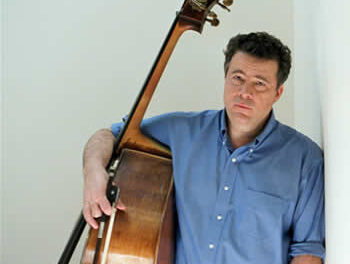This is the concert I’ve been patiently waiting to come along. It was grand. It was monumental. It was clean, on time and interesting, and the orchestra played with poise and maturity. But most important, they played with endurance. On this hot Sunday afternoon – July 30 – conductor David Effron was soaking wet afterward, but smiling, too.
Check it out: Three Dance Episodes from Leonard Bernstein’s On The Town, Miklós Rózsa’s Violin Concerto, Op. 24, with Robert McDuffie, and then Sergei Rachmaninov’s Symphony No. 2 in E minor, Op. 27 – a supposedly brooding and dark monument to his recovery from psychotherapy that seemed remarkably sunny in the context of this program.
In 1945 Bernstein broke out three numbers from the 1944 Broadway play On The Town to create a stand-alone concert work. The three are titled “The Great Lover,” “Lonely Town,” and “Times Square, 1944.” The show’s signature tune, “New York, New York” (not the famous Liza Minnelli tune of like title), is embedded, and the trio of pieces is remarkably descriptive of the era. There are exacting and quick rhythms, all well executed by the orchestra, and bluesy jazz themes in the clarinet and saxophone leaning on the Pentatonic scale. Grouped as fast-slow-fast, these Episodes are a tasty and exciting substitute for the traditional overture often used as a program opener.
Next we heard guest artist Robert McDuffie perform the Violin Concerto, Op. 24, by Miklós Rózsa. This is a fascinating fast-slow-fast work that leans heavily on rhythm to offset its strong Hungarian tonal but modal influence. Completed in 1954 and premiered two years later by Jascha Heifetz, it stands alone in soundscape and pace, using plenty of double stops on the violin to keep the player honest and immersing the orchestra in deep counting mode to produce exciting rhythms. Born in Hungary and educated in Leipzig, Rózsa spent time in Hollywood writing for films. Beginning in 1940, this tenure produced three Academy Awards including the 1959 score for Ben Hur. Violinist McDuffie, who also directs the Rome Chamber Orchestra, has made a career of this piece. His playing was from memory, sure, in tune, and fiery when needed.
After intermission, the BMC Orchestra performed the Second Symphony of Rachmaninov. This is a huge, demanding, late-romantic piece that will sap dry players who aren’t up to the task. It is just this point – endurance – that was expertly met by the orchestra members and David Effron, who conducted without a score. Welcome colors added to the ensemble included bass clarinet and contrabassoon. This work can sound familiar at times: there is the Dies Irae theme in the second movement that turns up later as the basis for the harmony in counterpoint. In this context, it sounds like Rachmaninov had fully recovered from the insecure days following the disastrous debut of his First Symphony. There is also a suspicious similarity to a Barry Manilow hit from the ’80s…. But that happens a lot with Rachmaninov, doesn’t it? Timpanist Tim Adams punctuated the downbeats, the brass section soared, the strings were lush, and the woodwinds were another colorful layer unto themselves.
This was a good one, and when the audio archive is made available you should listen to this program. Elvis came back into the building!












